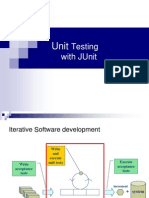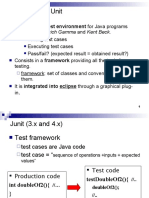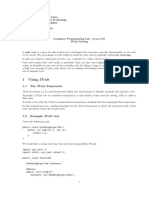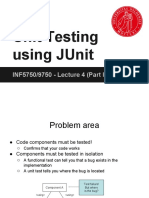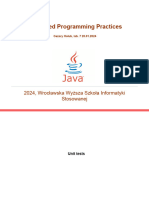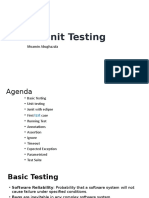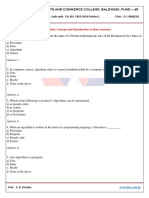CS 696 Mobile Phone Application Development
Fall Semester, 2009
Doc 6 Testing
Sept 16, 2009
Copyright , All rights reserved. 2009 SDSU & Roger Whitney, 5500
Campanile Drive, San Diego, CA 92182-7700 USA. OpenContent (http://
www.opencontent.org/opl.shtml) license defines the copyright on this
document.
�Testing & Subversion References
JUnit Cookbook http://junit.sourceforge.net/doc/cookbook/cookbook.htm
JUnit Test Infected: Programmers Love Writing Tests http://junit.sourceforge.net/doc/testinfected/testing.htm
JUnit Javadoc: http://www.junit.org/junit/javadoc/3.8/index.htm, http://junit.org/junit/javadoc/4.5/
JUnit FAQ, http://junit.sourceforge.net/doc/faq/faq.htm
Brian Maricks Testing Web Site: http://www.exampler.com/testing-com/
Testing for Programmers, Brian Marick, Available at: http://www.exampler.com/testing-com/writings.html
Android Examples supplied with Android 1.6
Android Documentation, http://developer.android.com/reference/android/test/ActivityTestCase.html
�Testing
Johnson's Law
If it is not tested it does not work
The more time between coding and testing
More effort is needed to write tests
More effort is needed to find bugs
Fewer bugs are found
Time is wasted working with buggy code
Development time increases
Quality decreases
�Unit Testing
Tests individual code segments
Automated tests
�What wrong with:
Using print statements
Writing driver program in main
Writing small sample programs to run code
Running program and testing it be using it
�When to Write Tests
First write the tests
Then write the code to be tested
Writing tests first saves time
Makes you clear of the interface & functionality of the code
Removes temptation to skip tests
�What to Test
Everything that could possibly break
Test values
Inside valid range
Outside valid range
On the boundary between valid/invalid
GUIs are very hard to test
Keep GUI layer very thin
Unit test program behind the GUI, not the GUI
�Common Things Programs Handle Incorrectly
Adapted with permission from A Short Catalog of
Test Ideas by Brian Marick,
http://www.testing.com/writings.html
Strings
Empty String
Collections
Empty Collection
Collection with one element
Collection with duplicate elements
Collections with maximum possible size
Numbers
Zero
The smallest number
Just below the smallest number
The largest number
Just above the largest number
8
�XUnit
Free frameworks for Unit testing
SUnit originally written by Kent Beck 1994
JUnit written by Kent Beck & Erich Gamma
Available at: http://www.junit.org/
Ports to many languages at:
http://www.xprogramming.com/software.htm
�Sample JUnit 4.x Example
import static org.junit.Assert.*;
import java.util.ArrayList;
import org.junit.Before;
import org.junit.Test;
public class HelloWorldTest {
int testValue;
@Test
public void testMe() {
assertEquals(1, testValue);
}
@Test(expected=IndexOutOfBoundsException.class)
public void testIndexOutOfBoundsException() {
ArrayList emptyList = new ArrayList();
Object notValid = emptyList.get(0);
}
@Before
public void initialize(){
testValue = 1;
}
}
@Test
public void foo() {
assertTrue(2 == testValue);
}
10
�JUnit Example - JUnit 3.x
Goal: Implement a Stack containing integers.
Tests:
Subclass junit.framework.TestCase
Methods starting with 'test" are run by TestRunner
import junit.framework.*;
public class TestStack extends TestCase {
public void testDefaultConstructor() {
Stack test = new Stack();
assertTrue("Default constructor", test.isEmpty() );
}
public void testSizeConstructor() {
Stack test = new Stack(5);
assertTrue( test.isEmpty() );
}
}
11
�Start of Stack Class
public class Stack {
int[] elements;
int topElement = -1;
public Stack() {
this(10);
}
public Stack(int size) {
elements = new int[size];
}
public boolean isEmpty() {
return topElement == -1;
}
}
12
�Assert Methods
assertTrue()
assertFalse()
assertEquals()
assertNotEquals()
assertSame()
assertNotSame()
assertNull()
assertNotNull()
fail()
For a complete list see
http://www.junit.org/junit/javadoc/3.8/index.htm/
allclasses-frame.html/junit/junit/framework/
Assert.html/Assert.html
13
�Testing the Tests
If can be useful to modify the code to break the tests
package example;
public class Stack {
int[] elements;
int topElement = -1;
etc.
public boolean isEmpty() {
return topElement == 1;
}
}
14
�Test Fixtures - JUnit 3.x
Before each test setUp() is run
After each test tearDown() is run
package example;
import junit.framework.TestCase;
public class StackTest extends TestCase {
Stack test;
public void setUp() {
test = new Stack(5);
for (int k = 1; k <=5;k++)
test.push( k);
}
public void testPushPop() {
for (int k = 5; k >= 1; k--)
assertEquals( "Pop fail on element " + k, test.pop() , k);
}
}
15
�Testing Exceptions - JUnit 3.x
public void testIndexOutOfBoundsException() {
ArrayList list = new ArrayList(10);
try {
Object o = list.get(11);
fail("Should raise an IndexOutOfBoundsException");
} catch (IndexOutOfBoundsException success) {}
}
Example is from the JUnit FAQ
16
�Android Testing
17
�Android JUnit
18
�Main Classes
ActivityUnitTestCase
Unit testing of your Activity
ActivityInstrumentationTestCase2
Functional Testing of activities
19
�DatabaseExampleTest
public class DatabaseExampleTest extends
ActivityInstrumentationTestCase2<DatabaseExample> {
public DatabaseExampleTest() {
super("edu.sdsu.cs696", DatabaseExample.class);
}
protected void setUp() throws Exception {
super.setUp();
}
public void testTest() {
assertTrue(2 == 2);
}
20
testTest is just to show a very simple test. It was the first test I ran to make sure I could run the framework
�Simple Test of View Existance
public void testPreconditions() {
Button readButton = getReadButton();
assertNotNull(getActivity());
assertNotNull(readButton);
}
private Button getReadButton() {
return (Button) getActivity().findViewById(edu.sdsu.cs696.R.id.read);
}
21
getActivity() is an existing method that returns the activity you are testing.
�Testing insert
public void testInsert() {
try {
Cursor result = getRowsWithName("Cat");
int rowCount = result.getCount();
assertTrue(rowCount == 0);
insert("10", "Cat");
result = getRowsWithName("Cat");
rowCount = result.getCount();
assertTrue(rowCount == 1);
} finally {
deleteCatRows();
}
}
22
�getRowsWithName()
private Cursor getRowsWithName(String name) {
Cursor result;
String[] columns = new String[] { DatabaseHelper.ID,
DatabaseHelper.NAME, };
String[] sqlArguments = new String[] { name };
result = getActivity().managedQuery(NameProvider.CONTENT_URI, columns,
" NAME = ?", sqlArguments, null);
return result;
}
23
�insert
private void insert(final String id, final String name) {
getActivity().runOnUiThread(new Runnable() {
public void run() {
EditText idField = getIDEditText();
EditText nameField = getNameEditText();
idField.setText((CharSequence) id);
nameField.setText((CharSequence) name);
Button insertButton = getInsertButton();
insertButton.performClick();
}
});
// wait for the request to go through
getInstrumentation().waitForIdleSync();
}
}
24
�Some Gets
private Button getInsertButton() {
return (Button) getActivity().findViewById(edu.sdsu.cs696.R.id.insert);
}
private EditText getIDEditText() {
return (EditText) getActivity().findViewById(
edu.sdsu.cs696.R.id.databaseId);
}
private EditText getNameEditText() {
return (EditText) getActivity().findViewById(edu.sdsu.cs696.R.id.name);
}
25
�delete
private void deleteCatRows() {
int rowsDeleted = getActivity().getContentResolver().delete(
NameProvider.CONTENT_URI, "NAME = 'Cat'", null);
Log.i("test", "deleted rows after insert " + rowsDeleted);
}
26
The Log.i method is not needed, but logging is one way to help find out what is going on when things don't work
�Monkey - Random Testing
27
�Monkey
Generates random events for your activity
Enters text
Click buttons
Selects menus
Rotates screen
etc.
28
�Terse output
Al pro 21->adb shell monkey -p edu.sdsu.cs696 500
// activityResuming(com.android.launcher)
29
�First Verbose Level
Al pro 22->adb shell monkey -p edu.sdsu.cs696 -v 500
:Monkey: seed=0 count=500
:AllowPackage: edu.sdsu.cs696
:IncludeCategory: android.intent.category.LAUNCHER
:IncludeCategory: android.intent.category.MONKEY
// Event percentages:
// 0: 15.0%
// 1: 10.0%
// 2: 15.0%
// 3: 25.0%
// 4: 15.0%
etc...
:Sending Pointer ACTION_UP x=304.0 y=6.0
:Sending Pointer ACTION_MOVE x=1.0 y=3.0
:Sending Pointer ACTION_MOVE x=-2.0 y=-3.0
:Dropped: keys=0 pointers=0 trackballs=0 flips=0
// Monkey finished
30

